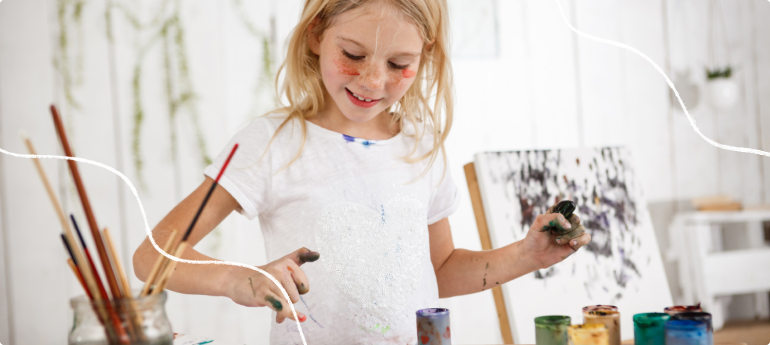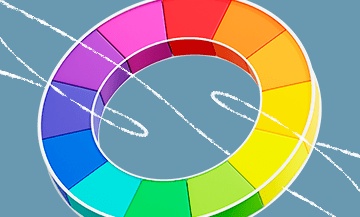The role of drawing in child development
Drawing is a magical world where children can express their thoughts, feelings, and imagination on paper. It is an art form that not only captivates but also plays a crucial role in the development of young personalities. In this article, I will discuss the impact of drawing on children’s development and why it is so important.
First, it’s worth noting that drawing helps develop hand motor skills. When a child holds a pencil or brush and tries to convey their thoughts on paper, they develop coordination and improve fine motor skills. This skill will be useful in the future.
Drawing fosters imagination and creativity. Children create their own worlds, characters, and stories. They learn to think creatively. Drawings become an excellent way for children to express their ideas, even if they are not yet proficient in speaking.
And finally, drawing builds healthy self-esteem. If your little one sees the result of their efforts — an interesting and beautiful drawing, their confidence in themselves also grows.
So let’s support and inspire our little artists. Encourage them in their desire to unlock their creative potential.


Children's drawing and teaching drawing to children from 6 months to one year (features of training, materials, techniques, recommendations)
Even the smallest children can be introduced to the art of drawing. However, it’s important to understand that at this age, the goal is not to create masterpieces but to develop motor skills, imagination, and perception of color and shape.
How to help a child take their first steps in creativity?
- At this age, it’s recommended to use special child-friendly art supplies that are safe for health. First drawings can be created with child-safe paints, chalks, pencils, or even fingers.
- Children are curious about everything new, so offer them a variety of colors — the diversity of shades will help them become more acquainted with the world around them.
- Avoid dictating strict instructions and rules. Allow children to create freely and express their imagination.
- It is important to praise the child and encourage all their creative efforts.
Materials for learning
 Child-safe paints: you will need eco-friendly child-safe paints free from harmful substances. Such paints are usually easy to wash off from skin and clothes — a relief for parents.
Child-safe paints: you will need eco-friendly child-safe paints free from harmful substances. Such paints are usually easy to wash off from skin and clothes — a relief for parents.

Paper: for drawing at this age, it is better to choose a sheet of paper, and an old newspaper or plastic wrap can be used as an improvised mat.

Brushes and chalks: you can start with finger painting, but gradually introduce children to brushes and chalks.
 Space and freedom: provide children with a comfortable space for drawing where they can move freely and create.
Space and freedom: provide children with a comfortable space for drawing where they can move freely and create.
Techniques and recommendations
- Finger painting: don’t scold children if they apply paint to paper with their fingers. On the contrary, it greatly develops tactile perception.
- Strokes and dots: try to offer the child chalk or a brush and show how to make different strokes and dots on paper.
- Mixing colors: children can experiment with mixing colors. For example, mixing yellow and blue will produce green.
- Play element: encourage children to draw their favorite character or animal.
Art begins here: children's drawing and the magic of creativity for children from one to three years old

Materials for Children’s Drawing at Age 3
 Large Crayons and Chalk: These tools are easy for little hands to hold and will help children make their first lines and drawings.
Large Crayons and Chalk: These tools are easy for little hands to hold and will help children make their first lines and drawings.

Modeling Clay: A wonderful material that develops motor skills.
 Finger Paints: With these, drawing becomes an engaging hobby. Children paint with their fingers directly on the paper, and parents don’t scold them — it’s the best fun imaginable.
Finger Paints: With these, drawing becomes an engaging hobby. Children paint with their fingers directly on the paper, and parents don’t scold them — it’s the best fun imaginable.
 Paints and Brushes: If your child is a bit older (from two years), you can try painting with paints and brushes. The little one will quickly master new techniques and play with colors.
Paints and Brushes: If your child is a bit older (from two years), you can try painting with paints and brushes. The little one will quickly master new techniques and play with colors.
Drawing Techniques for Toddlers
At the earliest stage of development, it’s important to give children freedom. Allow them to draw whatever comes to mind, even if it’s abstract blobs and circles.
- Following the Line: Draw a line on the paper and ask the child to repeat it with a crayon. This develops movement coordination in the very young.
- Mixing Colors: Let children mix colors and observe how shades change. You can even record the results of their experiment in a notebook.
Do not leave the child alone. Join your children, draw together, and come up with new ideas. It’s always more fun together.
The magic of children's drawings: the path to creativity for children from 3 to 6 years old
At the age of three to six, children are on the edge between the worlds of imagination and reality, and their creative potential blossoms during this period.
- Help children develop their individuality and creative approach. Allow them to draw what is meaningful to them.
- Teach children the basic elements of drawing — lines, shapes, and colors.
- Encourage children to use their imagination; let them draw their own worlds and characters.
- Try different drawing techniques: watercolor, oil, charcoal, pastel, and others. Look for new ways of self-expression.
Materials for Drawing
Colored Pencils and Crayons: At this age, children want to create more detailed drawings.

Water-Soluble Pencils and Watercolor.

Pastel and Oil Paints: Add richness and depth to the drawings.

Canvas and Art Paper: Finally, you can buy your child their first canvas — a vast space for their self-expression.
Drawing Techniques for Children Ages 3-6
- Modeling with Clay: The child creates three-dimensional figures and develops a sense of form.
- Pointillism: Suggest children use cotton swabs or cotton pads to create a picture made up of many dots.
- Impressionism and Strokes: You can try techniques of applying paint or pastel in strokes and layers.

Drawing dreams: a journey into the world of children's art from 6 to 9 years old
Children aged six to nine transfer their fantasies onto paper and can already create their first amazing works of art. This is the age when young artists begin to learn the basics of drawing and expand their creative potential.
Features of Learning
Now children start to approach drawing more seriously.
- Encourage children to express themselves through drawing. Let them tell their stories and pour their feelings and ideas directly onto paper.
- Deepen children’s understanding of drawing, continue teaching basic elements — lines, shapes, perspective, shades.
- Draw with watercolor, oil, pastel, charcoal, and other materials.
Materials
At this stage, you can introduce more diverse materials for creativity.
- Various Pencils and Markers: More colored pencils, markers, and felt-tip pens.
- Watercolor and Gouache: Children are now more conscious of their creativity and can draw well with watercolor or gouache.
- Something Unusual: Experiment with sand, fabric, or threads. There are no limits to creativity.

The blossoming of talent: the development of children's drawings from 9 to 12 years
Your child continues to develop their abilities and becomes a more independent artist. Hence, new approaches to children’s creativity emerge.
- Children begin to use drawing to express their thoughts, feelings, and ideas.
- At this age, they can delve deeper into the basic principles of drawing—perspective, shadows, and anatomy.
- Experimenting with different styles and materials is encouraged as the child searches for and expresses their own artistic voice.
Materials
Purchase professional markers of various thicknesses and colors, which will allow for bright and clear drawings. These markers are well-suited for outlines, coloring, and detailing.
Alternatively, use oil paints for those who particularly enjoy immersing themselves in the world of painting, creating rich and vibrant works. Working with oil paints further aids in the development of future artists’ skills.

Drawing Techniques
- Graphite and Shadows: teach children to create graphite drawings, working with shadows and light.
- Comics and Illustrations: this is an age when many children start showing interest in comics. Why not try drawing your own?
- Abstract Art: let the child continue to explore their style; abstract art is the simplest way to express oneself unconventionally.
Art and Self-Expression: Drawing for Teens 12 to 16 Years Old
Adolescents aged 12 to 16 are at the crossroads of childhood and adulthood, and drawing can be their means of self-expression. At this age, children already have more advanced artistic skills and a broad perception of the world.

Features of Learning
Teenagers develop a deeper understanding of themselves and the world around them. The art of drawing becomes a way to express complex emotions, ideas, and identity.
A parent or drawing teacher should encourage the child’s desire for self-expression. Remember what it was like at that age? It’s a time of rebellion, chaos, and first teenage problems. It’s great that all the worries and anxieties can be poured out onto a canvas or paper.
Teenagers seek greater independence and autonomy in their art. They can freely choose projects, themes, and styles that interest them. This kind of independence in creativity should not be criticized; on the contrary, it should be supported.
A teenager can excel in realism, classicism, or abstraction. The child’s soul now gravitates toward something more serious. So don’t hesitate to set tasks that require unconventional solutions in drawing.
Technicians
Encourage the child to draw in black-and-white graphics. The teenager will explore shading techniques, contours, and textures in more detail.
Boys and girls: the main differences in the drawing


Art is a language through which we express our thoughts, feelings, and perception of the world. Even from a very early age, children try to bring their inner worlds to life on paper. However, sometimes you may notice interesting differences in how boys and girls approach drawing.
Boys are more inclined to depict aggressive themes: battles, races, space adventures. Their drawings are filled with bright colors and dynamic lines, reflecting their desire for activity and competition.
Girls often choose emotional and gentle themes for their drawings: flowers, animals, princesses. The focus is on relationships, empathy, and beauty.
But you should know that our world is full of stereotypes, and every child is unique. A girl might enjoy drawing races, and a boy might love drawing nature.
It is important to support a child’s creativity, regardless of gender, and allow them to freely express themselves through drawing.
Drawing lessons at school: pros and cons
Pros:
- Development of Creativity: Drawing lessons foster creative thinking. They teach children to see the world in a different light and find beauty in details.
- Improvement of Coordination and Fine Motor Skills: Drawing requires precision and patience.
- Self-Expression and Emotional Relief: Art is a way to express feelings and emotions. By drawing, children can share their world and experiences.
- Broadening Horizons: Curricula often involve studying art from different eras and cultures.
- Future: Sometimes drawing is just a hobby, but it can also be a future profession. If your child shows creative abilities from a young age, they might become an artist, designer, architect, or illustrator in the future.

Cons:
- Children may feel that drawing within the constraints of curricula limits their creative freedom.
- Children start comparing their drawings to others’. Children’s self-esteem is often unstable, and they may doubt themselves and their abilities.
- School drawing lessons can sometimes be boring and unprofessional.
Non-standard drawing techniques for children
- Collect smooth, beautiful stones and have children paint mini-landscapes, animals, or abstract patterns on them using acrylic paints. Painting on stones is a great way to introduce children to nature.
- Children can try the technique of dabbing using napkins or cotton swabs. This technique creates interesting, unusual backgrounds for drawings. Plastic scrapers can be used to cut patterns into the top layer of paint.
- Salt painting combines the magic of chemistry and art in one. Sprinkle salt on a wet canvas, and apply watercolor paints over the salt. This will create modern and abstract paintings that can decorate a child’s room.
An unconventional approach to creativity turns the artistic process into an exciting adventure.

Advice for parents from a professional artist
- Inspire Together: The best way to ignite your children’s passion for art is to create with them. Visit museums, art exhibitions, paint, and sculpt with your child. Discuss works of art, ask questions, and show your interest and admiration.
- Allow Freedom of Expression: Remember that creativity is a personal expression of each individual. Don’t impose your own views on what is “right” or “wrong” in art.
- Teach to Appreciate Art: Educate children to appreciate art. Tell them about great artists of the past, the history of art, and how art has influenced our world.
- Help Make the First Step: Buy your child paints, pencils, easels, clay, and other materials. If your child shows interest in drawing—encourage their efforts.
Parents play a crucial role in the development of their children’s artistic abilities. Support your child in their creative journey, and you can help them grow into a talented individual.
7 reasons to enroll your child in drawing
- Fine Motor Skills When the renowned educator Vasily Alexandrovich Sukhomlinsky once said, “A child’s mind is at the tips of their fingers,” he highlighted the importance of developing fine motor skills in children—the ability to perform precise and delicate movements with their hands and fingers. This skill is related to attention, memory, vision, and the nervous system, and it is also closely linked to speech due to the positioning of speech and motor centers in the brain. Engaging a child in drawing can significantly improve their fine motor skills.
- Good Memory The art of drawing activates various parts of our brain associated with retaining and transforming visual images. Simply put, when we want to draw an object, we need to recall its color, shape, volume, texture, and proportions. The more a child draws, the better their memory will develop.
- Creativity The process of drawing fosters the development of unconventional thinking. Consider this: every brushstroke, every hand movement is a decision that plays a key role in creating a drawing or a complete picture. Moreover, through drawing, children learn to see their mistakes as opportunities for creativity and new discoveries.
- Communication Drawing teaches children to express their thoughts and feelings, as well as to read and interpret visual images.
- Preparation for School
 Engaging in drawing helps your child better adapt to school life, as it teaches them to follow instructions, adhere to routines, and solve assigned tasks.
Engaging in drawing helps your child better adapt to school life, as it teaches them to follow instructions, adhere to routines, and solve assigned tasks. - Goal Orientation The result of creativity is a completed picture. Through drawing, children learn to finish the work they start.
- Emotional Resilience Drawing is an incredibly meditative activity that promotes tranquility, especially when the focus is on the process rather than the final result. This is why drawing can be immensely beneficial for children prone to mood swings. Creativity is an effective way to manage stress, which can sometimes be as much or even more than that experienced by adults. It offers a way to release negative emotions and escape from intrusive and unpleasant thoughts.
Psychology of children's drawings
Children’s Drawings are an open window into their inner world, where every line, color, and image reveal the secrets and aspects of their psychological development.
Every mark on the paper, whether it’s a child’s first shaky attempts or the complex compositions of a teenager, carries a wealth of information. Children’s drawings are art without censorship, a space where they can freely convey their thoughts, feelings, and perceptions of the world, without being limited by words.
By exploring children’s drawings, psychologists and researchers can uncover not only the structure of a child’s personality but also traces of internal conflicts: joys, fears, dreams. Through this artistic medium, one can gain insight into the world of a child’s consciousness and unconsciousness.
Through drawing, children find a way to interact with the world around them, explore their own feelings and emotions, and communicate with adults and peers. Drawings can reflect a child’s imagination, creativity, and individuality, and help us understand how our children adapt to a complex reality.
That’s why drawing is so important. Your children’s drawings will certainly tell you about the world in which your little artists live—full of joys and experiences.
Question-answer
First and foremost, drawing promotes the development of creative thinking. When little ones pick up brushes and palettes, they start creating their own world, expressing ideas, feelings, and fantasies on the canvas. Imagination and the ability to think outside of ready-made templates are developed.
Additionally, drawing teaches children to be observant. They begin to notice the details of the surrounding world, colors, shapes, and textures. This skill helps them better understand and explore their environment.
Children can start exploring the world of art from their earliest months. The first “masterpieces” often appear as colorful fingerpaint spots and gentle watercolor strokes.
As they grow older, children can move on to more complex forms of drawing.
- Art schools and courses: children under the guidance of professional artists learn about different techniques and styles of art, and they also get to interact with other like-minded peers.
- Online resources: in the digital age, children can learn drawing through online classes, video tutorials, or drawing apps.
- Nature and the surrounding world: sometimes the best drawing lesson is right outside the window. Nature, animals, and architectural wonders of the surrounding world can all serve as sources of inspiration.




